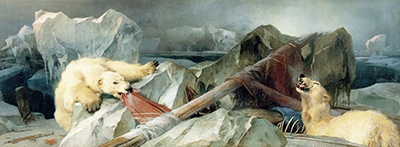Completed in 1864, Man Proposes, God Disposes is an oil on canvas painting. It was inspired by Franklin’s lost expedition, said to have disappeared in 1840 in the Arctic. The scene depicts two polar bears in scattered wreckage of the expedition.
Landseer also paints the tattered remains of a red ensign, a telescope, human bones and a sail. These images area symbol of civilization and humanity overcome by nature, a commentary to the crisis of the British imperialism in the 19th century. Man Proposes, God Disposes is a phrase that can be translated to H*mo proponit, sed Deus disponit in Latin, as paraphrased by Thomas a Kempis in the imitation of Christ.
Some people use Bible translations in Proverbs 19:21. This painting depicts terror, pathos and poetry. It is formed from the urban myth that in the 1920s or 1930s, a student sitting for their exams stabbed a pencil in their eye and wrote that ‘the polar bears made me do it’ on their exam paper and committed suicide.
Landseer captured the imagination of the disappearance of the HMS Erebus and the HMS Terror with 129 men in a very creative way. After 20 years of disappearance, the fate was made known after Francis Leopold McClintock, the Royal Navy officer, discovered the remains of the crew. Man Proposes, God Disposes was, in this case, viewed as the most defined artwork. Landseer was careful to include the grisly remains of the men and polar bears in his painting.
In the artwork are two polar bears seen tearing the rugs apart. One of them has a human rib in the mouth. The boat is wooden, and this was the one said to have been dragged to the lone island after it was abandoned by the crew. On the far-left side of the painting is a prow with a mask splitting the boat into two.
Landseer is believed to have used a theatrical object with lights on both sides. Notice the tip of the iceberg on the foreground appearing to be lit from above. On the right side is a form of nightly light, with the source of light appearing to be dimmed by the heap of debris.
Landseer used McClintock’s book as his source of visual inspiration. He was careful to capture the imaginary murky sky. Although he did not include an engraving illustration of the funeral, Landseer paid more attention to the description of the phenomenon. The most highlighted point of relevance in this gruesome artwork is the sight of the polar bears in the ice.




